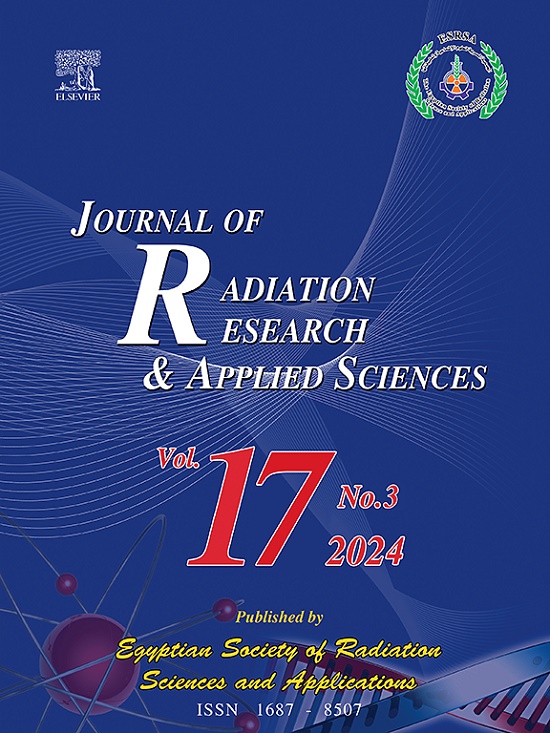Investigating the impact of thermal radiation, induced magnetic force, and convective boundary condition on MHD nanofluid flows
IF 1.7
4区 综合性期刊
Q2 MULTIDISCIPLINARY SCIENCES
Journal of Radiation Research and Applied Sciences
Pub Date : 2025-05-12
DOI:10.1016/j.jrras.2025.101572
引用次数: 0
Abstract
A numerical model is developed to investigate the heat and mass transfer characteristics of a two-dimensional Maxwell nanofluid flow over an expanding/shrinking surface under the influence of thermal radiation and an induced magnetized force. The governing nonlinear differential equations, which account for magnetohydrodynamic (MHD) effects and viscoelastic fluid behavior, are solved numerically using the Runge-Kutta-Fehlberg (RKF45) method. The study aims to obtain detailed profiles for velocity, temperature, and concentration distributions under varying physical parameters.
The results indicate that the Deborah number significantly enhances the flow velocity due to the elastic nature of the Maxwell fluid. An increase in the magnetic parameter (M) leads to a suppression of the velocity field as a result of the Lorentz force while simultaneously strengthening the induced magnetic field. The thermal radiation parameter (Nr) positively impacts the temperature distribution, thereby increasing the thermal boundary layer thickness. Furthermore, the Lewis number (Le) is found to reduce concentration levels, indicating dominant thermal over mass diffusivity.
Overall, the study provides new insights into the coupled effects of magnetic induction, radiative heat transfer, and fluid elasticity on nanofluid transport behaviour, which has practical implications in material processing, energy systems, and biomedical engineering applications.
研究热辐射、感应磁力和对流边界条件对MHD纳米流体流动的影响
建立了二维麦克斯韦纳米流体在热辐射和感应磁化力作用下在膨胀/收缩表面上流动的传热传质特性的数值模型。采用Runge-Kutta-Fehlberg (RKF45)方法对考虑磁流体动力学(MHD)效应和粘弹性流体行为的非线性控制微分方程进行了数值求解。该研究旨在获得在不同物理参数下的速度、温度和浓度分布的详细剖面。结果表明,由于麦克斯韦流体的弹性特性,黛博拉数显著提高了流体的流动速度。磁参数(M)的增大,由于洛伦兹力的作用,速度场受到抑制,同时感应磁场增强。热辐射参数(Nr)正影响温度分布,从而增加热边界层厚度。此外,发现路易斯数(Le)降低了浓度水平,表明热扩散率高于质量扩散率。总的来说,该研究为磁感应、辐射传热和流体弹性对纳米流体输运行为的耦合效应提供了新的见解,这在材料加工、能源系统和生物医学工程应用中具有实际意义。
本文章由计算机程序翻译,如有差异,请以英文原文为准。
求助全文
约1分钟内获得全文
求助全文
来源期刊

Journal of Radiation Research and Applied Sciences
MULTIDISCIPLINARY SCIENCES-
自引率
5.90%
发文量
130
审稿时长
16 weeks
期刊介绍:
Journal of Radiation Research and Applied Sciences provides a high quality medium for the publication of substantial, original and scientific and technological papers on the development and applications of nuclear, radiation and isotopes in biology, medicine, drugs, biochemistry, microbiology, agriculture, entomology, food technology, chemistry, physics, solid states, engineering, environmental and applied sciences.
 求助内容:
求助内容: 应助结果提醒方式:
应助结果提醒方式:


